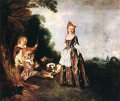Paintings > Art styles > Rococo
 Rococo, less commonly roccoco, or "Late Baroque", is an 18th-century artistic movement and style, affecting many aspects of the arts including painting, sculpture, architecture, interior design, decoration, literature, music, and theatre. It developed in the early 18th century in Paris, France as a reaction against the grandeur, symmetry, and strict regulations of the Baroque, especially of the Palace of Versailles. Rococo artists and architects used a more jocular, florid, and graceful approach to the Baroque. Their style was ornate and used light colours, asymmetrical designs, curves, and gold. Unlike the political Baroque, the Rococo had playful and witty themes. The interior decoration of Rococo rooms was designed as a total work of art with elegant and ornate furniture, small sculptures, ornamental mirrors, and tapestry complementing architecture, reliefs, and wall paintings. The Rococo was also important in theatre. The book The Rococo states that no other culture "has produced a wittier, more elegant, and teasing dialogue full of elusive and camouflaging language and gestures, refined feelings and subtle criticism" than Rococo theatre, especially that of France.
Rococo, less commonly roccoco, or "Late Baroque", is an 18th-century artistic movement and style, affecting many aspects of the arts including painting, sculpture, architecture, interior design, decoration, literature, music, and theatre. It developed in the early 18th century in Paris, France as a reaction against the grandeur, symmetry, and strict regulations of the Baroque, especially of the Palace of Versailles. Rococo artists and architects used a more jocular, florid, and graceful approach to the Baroque. Their style was ornate and used light colours, asymmetrical designs, curves, and gold. Unlike the political Baroque, the Rococo had playful and witty themes. The interior decoration of Rococo rooms was designed as a total work of art with elegant and ornate furniture, small sculptures, ornamental mirrors, and tapestry complementing architecture, reliefs, and wall paintings. The Rococo was also important in theatre. The book The Rococo states that no other culture "has produced a wittier, more elegant, and teasing dialogue full of elusive and camouflaging language and gestures, refined feelings and subtle criticism" than Rococo theatre, especially that of France.By the end of the 18th century, Rococo was largely replaced by the Neoclassic style. In 1835 the Dictionary of the French Academy stated that the word Rococo "usually covers the kind of ornament, style and design associated with Louis XV's reign and the beginning of that of Louis XVI". It includes therefore, all types of art from around the middle of the 18th century in France. The word is seen as a combination of the French rocaille (stone) and coquilles (shell), due to reliance on these objects as decorative motifs.The term may also be a combination of the Italian word "barocco" (an irregularly shaped pearl, possibly the source of the word "baroque") and the French "rocaille" (a popular form of garden or interior ornamentation using shells and pebbles) and may describe the refined and fanciful style that became fashionable in parts of Europe in the 18th century. Owing to Rococo love of shell-like curves and focus on decorative arts, some critics used the term to derogatively imply that the style was frivolous or merely modish. When the term was first used in English in about 1836, it was a colloquialism meaning "old-fashioned". The style received harsh criticism and was seen by some to be superficial and of poor taste, especially when compared to neoclassicism; despite this, it has been praised for its aesthetic qualities and since the mid-19th century, the term has been accepted by art historians. While there is still some debate about the historical significance of the style to art in general, Rococo is now widely recognized as a major period in the development of European art.
Source: wikipedia
-
 $AU 228.55 ~ 942.60
$AU 228.55 ~ 942.60 -
 $AU 240.36 ~ 4,282.55
$AU 240.36 ~ 4,282.55 -
 $AU 281.66 ~ 1,146.12
$AU 281.66 ~ 1,146.12 -
 $AU 267.86 ~ 7,026.01
$AU 267.86 ~ 7,026.01 -
 $AU 344.48
$AU 344.48 -
 $AU 254.65 ~ 2,147.87
$AU 254.65 ~ 2,147.87 -
 $AU 273.43 ~ 1,195.54
$AU 273.43 ~ 1,195.54 -
 $AU 271.58 ~ 2,695.56
$AU 271.58 ~ 2,695.56 -
 $AU 265.93 ~ 3,431.17
$AU 265.93 ~ 3,431.17 -
 $AU 833.54
$AU 833.54 -
 $AU 240.30 ~ 902.30
$AU 240.30 ~ 902.30 -
 $AU 248.86 ~ 978.01
$AU 248.86 ~ 978.01 -
 $AU 283.42 ~ 1,161.84
$AU 283.42 ~ 1,161.84 -
 $AU 603.37
$AU 603.37 -
 $AU 411.00
$AU 411.00 -
 $AU 280.02 ~ 2,379.40
$AU 280.02 ~ 2,379.40 -
 $AU 535.60
$AU 535.60 -
 $AU 259.80 ~ 952.66
$AU 259.80 ~ 952.66 -
 $AU 440.51
$AU 440.51 -
 $AU 376.55
$AU 376.55 -
 $AU 246.78 ~ 959.77
$AU 246.78 ~ 959.77 -
 $AU 248.76 ~ 1,374.42
$AU 248.76 ~ 1,374.42 -
 $AU 244.50 ~ 3,552.78
$AU 244.50 ~ 3,552.78 -
 $AU 217.55 ~ 2,536.84
$AU 217.55 ~ 2,536.84 -
 $AU 219.64 ~ 1,731.29
$AU 219.64 ~ 1,731.29 -
 $AU 242.69 ~ 1,270.50
$AU 242.69 ~ 1,270.50 -
 $AU 249.43 ~ 983.15
$AU 249.43 ~ 983.15 -
 $AU 244.33 ~ 1,913.66
$AU 244.33 ~ 1,913.66


